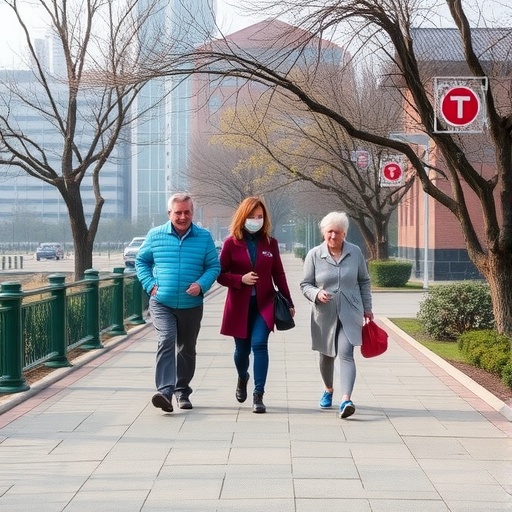In a groundbreaking endeavor that tackles the essential need for active travel among older adults, researchers from China embarked on an observational study highlighting the dynamics present in Daokou ancient town. This quaint location, rich in history, becomes a vibrant backdrop for understanding how urban environments can facilitate or hinder the mobility and wellbeing of their elderly populations. The study, illustrated by the contributions of Wang, Lv, and Li, investigates the subtle yet crucial elements of neighborhood design that can motivate older individuals to engage in active forms of transportation such as walking and cycling.
The necessity for such research emerges against the backdrop of an increasingly aging population globally, where more individuals are living longer lives. However, with longevity comes the risk of diminishing physical activity, leading to a plethora of health concerns such as cardiovascular diseases, obesity, and decreased mental health. Harnessing the power of active travel is a profound strategy to counter these risks, and understanding how to activate this potential in older adults could lead to public health improvements worth millions. By providing a framework within which seniors can remain mobile and socially engaged, communities stand to gain from improved overall health and reduced healthcare costs.
Daokou ancient town is not merely a setting; it represents a microcosm of modern challenges faced by older citizens in developing urban areas. The study observed various aspects such as street design, the presence of pedestrian zones, and local amenities that contribute to a walking-friendly neighborhood. The researchers conducted their observations thoroughly, highlighting factors such as sidewalk quality, the availability of benches, and traffic patterns that could either encourage or deter seniors from embarking on active travel routes. These elements, seemingly minute, play a significant role in creating an environment that fosters independence and movement.
One innovative aspect of this study is the incorporation of real-world observations rather than theoretical models alone. By capturing the daily experiences of older adults within the streets of Daokou, the researchers paint a vivid picture of the actual barriers faced versus those anticipated by urban planners. This genuine perspective sheds light on the tangible ways that certain features can encourage or restrict mobility, making it essential reading for urban developers aiming to create more senior-friendly environments. Drawing from empirical evidence lends a weight of credibility that enhances the study’s relevance and applicability in practical settings.
Social interactions are also critically examined. The study notes that neighborhoods inviting active travel become natural hubs for social engagement among seniors. Public spaces that allow for casual encounters, whether at local markets or community parks, fundamentally shift the narrative around isolation and loneliness frequently experienced by older adults. As these travelers navigate their streets, they are not just exercising; they are forging connections, sharing experiences, and creating an informal support network crucial for mental wellbeing.
Transportation policy often overlooks older adults as a distinct demographic, leading to a one-size-fits-all approach that fails to address their unique needs. Through its findings, this research underscores the importance of tailored policies that recognize the significance of walkable neighborhoods. By providing recommendations rooted in observation, the authors advocate for urban planners and local governments to rethink how they approach senior mobility, perhaps reconfiguring public spaces to be safer and more accommodating.
One of the compelling conclusions drawn from this study indicates that infrastructure investments, such as wider sidewalks and more pedestrian crossings, could yield a significant boost in active travel among older adults. As cities around the world grapple with how to promote healthier lifestyles, this research offers a clear and actionable blueprint for enhancing public spaces. The interplay between urban design and health outcomes is more evident than ever, prompting stakeholders to reconsider how investments are directed within the urban landscapes.
Furthermore, emphasizing the importance of naturally integrating physical activity into daily routines, the findings advocate for a paradigm shift within the discourse of aging and mobility. Rather than isolating physical activity as an exercise-focused endeavor, the focus must shift to viewing it as a seamless part of daily life—an essential behavior naturally encouraged by strategic urban design. Integrating features that enthuse and enable active travel ultimately translates into holistic life enhancements for the elderly community.
Collaboration among community stakeholders is another important theme that recurs within the research. Local governments, city planners, and community organizations must work hand-in-hand to develop environments conducive to active senior travel. Engaging older adults in the planning process ensures that their voices are heard, leading to designs that truly cater to their needs and preferences. As advocates for aging populations come together with planners and policymakers, a collective vision emerges, enhancing the vibrancy and accessibility of our neighborhoods.
Interestingly, the implications of the study reach beyond the immediate context of Daokou ancient town. Lessons learned can apply to various urban settings around the globe, especially those facing similar challenges of rapid urbanization coupled with demographic shifts towards an aging population. International urban planning communities can take insights from this research and implement relevant recommendations to create healthier environments that bolster community cohesion and individual wellbeing.
In conclusion, the research conducted by Wang, Lv, and Li serves as a potent reminder that fostering active travel among older adults is not merely a public health concern; it is a fundamental human rights issue ensuring that seniors can lead fulfilling, independent lives within their communities. By promoting active, vibrant neighborhoods, there lies an opportunity to unlock the rich potential of aging populations. This study calls for urgent action, urging stakeholders across various sectors to prioritize creating environments that celebrate mobility and inclusion at every age as we strive for healthier, happier communities.
The nuances revealed in the observations carried out in Daokou offer not only local insights but also meaningful direction toward global urban practices aimed at supporting the aging segment of the population. This research presents a unique confluence of health, mobility, and urban design in the modern age, serving as an essential contribution to the field of gerontology and urban planning alike.
As we look to the future, embracing active travel not only improves individual lives but also enhances the social fabric of communities entirely. Empathy toward the mobility challenges faced by older adults can guide the strategic reimagining of urban spaces and policies, fostering age-friendly environments where movement is a revitalized part of everyday life. This vision aligns with broader public health goals and societal progress, providing a blueprint towards accessible, engaged, and active communities for all ages.
Subject of Research: Active travel promotion for older adults in urban areas
Article Title: Promote older adults active travel on neighborhood streets: an observation study in Daokou ancient town in China.
Article References:
Wang, Z., Lv, H. & Li, G. Promote older adults active travel on neighborhood streets: an observation study in Daokou ancient town in China.
BMC Geriatr 25, 790 (2025). https://doi.org/10.1186/s12877-025-06321-w
Image Credits: AI Generated
DOI: 10.1186/s12877-025-06321-w
Keywords: Active travel, older adults, urban planning, mobility, neighborhood design, public health, social engagement, infrastructure, aging population.
Tags: active travel for seniorschallenges of aging populationDaokou ancient town studyfostering community health for older adultshealth benefits of active transportationimproving senior wellbeing through mobilityneighborhood design and elderly engagementobservational study on senior mobilitypromoting walking and cycling among older adultspublic health strategies for seniorsreducing healthcare costs through active livingurban design for elderly mobility





